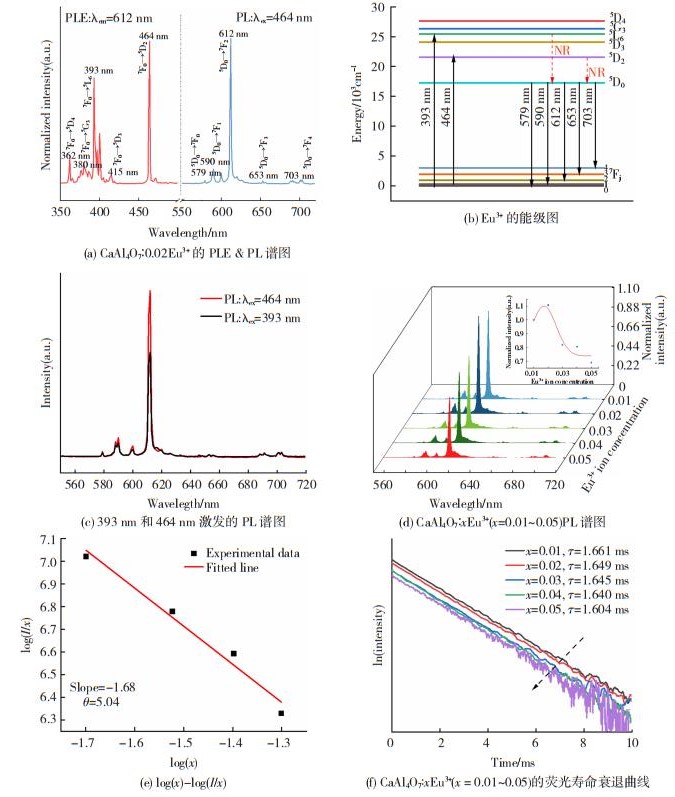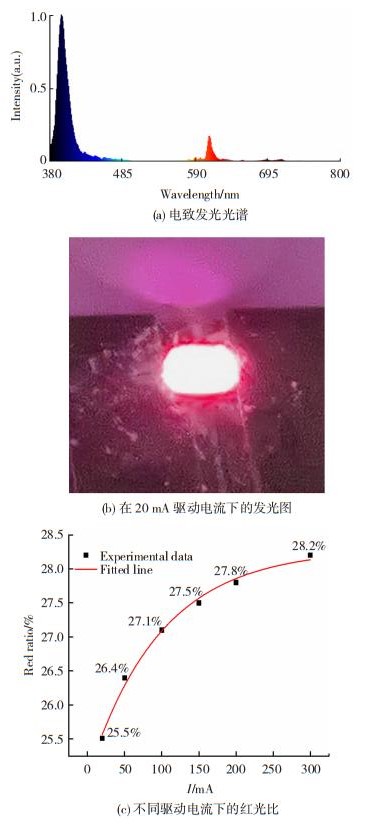2. 广西柳钢物流有限责任公司,广西 柳州 545002;
3. 广西大学 化学化工学院,南宁 530004
2. Guangxi Liugang Logistics Co., Ltd., Liuzhou 545002, China;
3. School of Chemistry and Chemical Engineering, Guangxi University, Nanning 530004, China
荧光粉转换白色发光二极管(Pc-wLED)具有使用寿命长,发光强度高,发光效率高,绿色环保等优异特性,其作为现代固体照明的重要组成部分被广泛用于各个领域[1]。目前,商业应用的Pc-wLED主要由黄光荧光粉Y3Al5O12∶ Ce3+与蓝光InGaN芯片结合获得,由于缺乏红光成分,其存在显色度低(CRI<80),色温高(CCT> 5 000 K) 等缺点,严重地限制了Pc-wLED的应用[2]。此外,LED的工作温度高达约150 ℃,这就需要荧光粉在工作温度范围内能够保持较好的热稳定性[3]。因此,获取具有优异热稳定性的红光荧光粉对LED的应用具有重要意义。
CaAl4O7具有较好的化学稳定性、优良的力学性能和热稳定性,且在紫外-近红外光谱范围内具有较高的光学透明度,是近年来铝酸钙晶体化合物中最受欢迎的发光材料之一[4],诸多发光离子被尝试与之结合制备荧光材料,例如:Mn4+[5]、Eu3+[6]、Sm3+[7]等,但对于如何才能获得具有优异高温荧光性能的铝酸盐基荧光粉,使其在WLEDs工作温度下仍然保持发光强度不变,尚有许多的研究工作需要进行。为此,本文首次采用共沉淀法制备CaAl4O7∶Eu3+系列荧光粉,探究其中最佳发光样品在30~240 ℃测试温度范围内的荧光热稳定性。
1 实验 1.1 试剂与仪器本实验采用Al(NO3)3·9H2O(A.R.),Ca(NO3)2 ·4H2O(A.R.),Eu(NO3)3 ·6H2O(A.R.) 作为原料,草酸铵((NH4)2C2O4·H2O)(A.R)作为共沉淀剂。以上试剂均购于阿拉丁试剂(上海)有限公司。
采用日本理学公司Rigaku D/max 2500V型X射线衍射仪(Power-XRD)对晶体的物相结构进行表征;使用日本日立公司Hitachi SU8220型扫描电镜(SEM)对样品进行形貌分析,搭配能谱仪(EDS)对微区各元素分布进行表征;用美国HORIBA公司的Fluoro Max4型荧光光谱仪测试样品在室温条件下的激发光谱和发射光谱(photoluminescence excitation and photoluminescence (PLE & PL)),搭配Tap-20 300 ℃高温荧光分析仪对样品进行加热可实现变温荧光光谱测试;采用Edinburgh FLS980荧光光谱仪进行荧光寿命测试;使用CIE1931软件计算特征发射光谱的色坐标。
1.2 样品的制备本文采用共沉淀法合成一系列CaAl4O7∶ xEu3+ (x=0.01,0.02,0.03,0.04,0.05;x为摩尔分数)荧光粉(样品(i)-(v))。以制备0.01 mol最佳样品CaAl4O7∶0.02Eu3+为例:1)按化学计量比称量0.04 mol Al(NO3)3·9H2O,0.009 8 mol Ca(NO3)2·4H2O,0.002 mol Eu(NO3)3·6H2O置于100 mL的玻璃烧杯中,加入40 mL去离子水搅拌溶解得到均匀混合溶液;2)以n草酸铵 ∶n总金属离子 = 2 ∶1的比例称取0.1 mol草酸铵作为沉淀剂置于另一个烧杯中,并加入一定量去离子水溶解;3)将金属离子混合溶液滴加到草酸铵溶液中,同时滴入氨水溶液,将PH值始终维持在8~9,将生成白色沉淀物;4)滴加完成后,所得悬浊液在60 ℃的加热条件下持续搅拌1 h,并静置陈化10 h;5)将陈化后的悬浊液进行抽滤、烘干,可得到白色粉末状前驱体,研磨后将其移入石英坩埚内置于马弗炉中,在1 000 ℃下煅烧4 h;6)退火结束,将煅烧产物研磨成粉末即得到最终样品。其他掺杂比例样品的制备同上,只需改变摩尔计量比即可。
2 结果与分析 2.1 物相组成及形貌图 1(a)为本实验所制备样品的X射线衍射谱图与基质CaAl4O7标准卡片(PDF#23-1037)的对比图,可以看出各样品的衍射峰与标准卡片数值基本保持一致,表明使用共沉淀法成功合成了CaAl4O7晶体,掺杂0.01~0.05Eu3+对晶体结构未造成明显影响。

|
图 1 CaAl4O7∶Eu3+的结构、形貌及元素组成 Fig.1 Structure, morphology, and elemental composition of CaAl4O7∶Eu3+: (a) XRD patterns of samples; (b) SEM image of CaAl4O7∶0.02Eu3+; (c) EDS spectrum of CaAl4O7∶0.02Eu3+ sample and surface distribution of each element |
CaAl4O7属于单斜对称晶系,空间群为C2/c,晶胞参数a=1.288 8 nm,b=0.888 8 nm,c=0.544 3 nm,α=90°,β=106.93°,γ=90°和V=0.596 5 nm3[7]。与Al3+的离子半径(r=0.039 nm) 相比,Eu3+的离子半径(r=0.094 7 nm)与Ca2+离子半径(r=0.106 nm)更接近, 则Eu3+离子更倾向于取代基质中Ca2+离子格位,此种取代在文献报道的结果中早已得到证实[8-9]。图 1(b)为CaAl4O7∶0.02Eu3+的扫描电镜图像,可看出该粉末主要由粒径3~20 μm的无规则块状晶体组成。在晶体表面存在微裂纹,主要是由于高温煅烧所造成。
图 1(c)为样品CaAl4O7∶0.02Eu3+的EDS能谱图,可以看出,样品的元素组成为O, Al, Ca, Eu元素。图 1(c)中的插图为样品所对应的扫描电镜图和Ca,Al,Eu,O各元素面分布图,由图可得Ca, Al, Eu, O元素均匀分布在样品内,该结果进一步证明了样品的元素组成及Eu3+已经成功掺杂到基质中。
2.2 CaAl4O7∶Eu3+的荧光特性图 2(a)为CaAl4O7∶0.02Eu3+的室温PLE &PL谱图。图 2(b)为Eu3+的光谱能级图。

|
图 2 室温下CaAl4O7∶Eu3+的荧光特性 Fig.2 Fluorescence characteristics of CaAl4O7∶Eu3+ at room temperature: (a) PLE and PL spectra of CaAl4O7∶0.02Eu3+; (b)energy level diagram of Eu3+; (c)PL spectra excited at 393 and 464 nm respectively; (d) PL spectra of CaAl4O7 ∶xEu3+ (x=0.01~0.05); (e) log(x)-log(I/x); (f) decay curves of CaAl4O7∶ xEu3+(x= 0.01~0.05) |
在PLE光谱中存在4个特征激发峰,分别位于362 nm (7F0→5D4),380 nm(7F0→5G3),393 nm(7F0→5L6),415 nm(7F0→5D3)和464 nm(7F0→5D2)处,其中,最强激发峰位于464 nm处,次强峰位于393 nm。在PL光谱中可以观察到5个Eu3+的特征发射峰,分别位于579 nm(5D0→7F0)、590 nm (5D0→7F1)、612 nm(5D0→7F2)、653 nm(5D0→7F3) 和703 nm(5D0→7F4)。612 nm (5D0→7F2)属于对晶体场变化超敏感的电偶极跃迁[10-11]。
在590 nm的发射峰为对晶体场变化不敏感的5D0→7F1磁偶极跃迁。磁偶极跃迁/电偶极跃迁发光强度比越大,则Eu3+占据反演对称位。反之,Eu3+占据非反演对称位。显然,在本实验中,612 nm的峰为最强峰,可归属为电偶极跃迁主导的发光,因此所对应的Eu3+占据非反演对称位。
图 2(c)为分别在393和464 nm激发波长下激发所得的PL谱图,可观察到464 nm激发获得的发射光谱荧光强度高于393 nm激发的荧光强度,发射光谱的形状和位置基本无变化,都能得到5D0→7F2跃迁为主的红光发射光谱。
图 2(d)为样品CaAl4O7∶ xEu3+的PL谱图,可以看到,随着Eu3+掺杂浓度的增加,荧光发射强度先提高后降低,最佳掺杂浓度为0.02,即临界浓度为0.02,当掺杂浓度大于0.02时,由于浓度猝灭现象,发射强度逐渐降低。
通过临界距离参数Rc可以判断导致浓度猝灭的能量传递机理,当Rc < 0.5 nm,能量传递机制为交换相互作用;当Rc>0.5 nm时,能量传递机制为电多极相互作用。Rc的值可以通过下式计算[12]。
| $ {\mathit{R}_\mathit{c}} \approx 2{\left( {\frac{{3\mathit{V}}}{{4{\rm{ \mathit{ π} }}{\mathit{x}_c}\mathit{N}}}} \right)^{\frac{1}{3}}} $ | (1) |
式中:N为单位晶胞化学式单位的数目;V为晶胞体积;xc为临界浓度。在本实验中,V=0.596 5 nm3,xc=0.02,N=4,带入式(1)计算得到Rc= 2.424 nm>0.5 nm,因此,Eu3+离子之间的浓度猝灭机制为电多级-电多级相互作用。根据Dexter等人的研究,可用下式判断电多级相互作用的类型[12-13]。
| $ \frac{\mathit{I}}{\mathit{x}} = \mathit{K}{\left[ {1 + \mathit{\beta }{{\left( \mathit{x} \right)}^{\mathit{\theta /}{\rm{3}}}}} \right]^{ - {\rm{1}}}} $ | (2) |
式中:K, β为常数;x为激活剂浓度;I为荧光发射强度。当θ=6,8,10时,对应的电多极相互作用分别为电偶极-电偶极相互作用,电偶极-电四极相互作用,电四极-电四极相互作用。图 2(e)为log(x)与log(I/x)的线性拟合关系图,由该图得到的斜率为-1.68,则θ为5.04。θ数值与6比较接近,故本实验中Eu3+的浓度猝灭机制应为电偶极-电偶极相互作用。
图 2(f)为CaAl4O7∶ xEu3+(x=0.01~0.05)在612 nm波长监测下所得的荧光寿命衰退曲线,利用单指数曲线公式进行拟合[14],得到
| $ {\mathit{I}_\mathit{t}} = {\mathit{I}_0} + \mathit{A}{\rm{exp}}\left( {\frac{{ - \mathit{t}}}{\mathit{\tau }}} \right) $ | (3) |
式中:It和I0分别代表在t和t0时的发射强度;A为常数;τ为样品的荧光寿命。由图 2(f)可看出曲线形状大致相同。当掺杂量从0.01增加到0.05时,相对应的荧光寿命分别为1.661,1.649, 1.645, 1.640和1.604 ms。荧光寿命随着Eu3+浓度的增加缓慢减短。当Eu3+浓度增大,基体中相邻Eu3+的平均距离缩短,离子间的相互作用力和能量传递增强,进而导致荧光寿命缩短[15]。
2.3 荧光热稳定性荧光热稳定性对于荧光粉的应用具有极为重要的意义,LED芯片工作时,其表面温度升至150 ℃左右,因此高质量的荧光粉应具备高温荧光稳定性。CaAl4O7∶0.02Eu3+荧光热稳定性如图 3所示。图 3(a)为CaAl4O7∶0.02Eu3+在464 nm波长激发下,30~240 ℃温度范围内的PL谱图。其中插图为发射光积分强度随着温度的变化曲线,可以看出,随着温度的升高,PL谱图的形状和位置并没有发生明显的变化。当温度由30 ℃升至90 ℃,随着温度的升高荧光强度不断增强,在90 ℃时荧光强度增加了14.5%,且当温度大于180 ℃后发光强度才低于初始荧光强度。这种现象被称做发光的负热猝灭效应(the Negative Thermal Quenching (NTQ) effect)。类似的负热猝灭效应也出现在Na3Sc2(PO4)3∶Eu3+[16]、Ba2La4Y4(SiO4)6O2∶Eu3+[17],Ca2LnSbO6∶Eu3+[18]荧光粉中。对于该效应,有文献[3, 19]从基质缺陷所形成的电子陷阱解释了相应的机理,即随着温度的升高,电子从电子陷阱中获得能量补偿,进而产生了该效应。

|
图 3 CaAl4O7∶0.02Eu3+的变温荧光热性能 Fig.3 Fluorescence thermal properties of CaAl4O7∶0.02Eu3+ at variable temperatures: (a) PL spectra at different temperatures; (b) activation energy curves of thermal quenching; (c) CIE chromaticity diagram; (d)schematic illustration of negative thermal quenching mechanism; (e)decay curves at variable temperatures |
在CaAl4O7∶Eu3+中同样可以用这样的机理来说明。Eu3+不等价取代Ca2+在基质中的晶格位点,根据晶体结构缺陷理论,为了保持电荷平衡,基质中会生成阳离子空位Vca″和间隙阴离子Oi″两种缺陷,由化学式3Ca2+→2Eu3++Vca″, 3Ca2+→3Eu3++Oi″可得[18]。而这些缺陷较适合形成电子陷阱,从而使CaAl4O7∶Eu3+的发光具有负热猝灭效应。显然,在该效应的支撑下,CaAl4O7∶Eu3+具有比较高的发光热稳定性。如在温度高达150 ℃时,荧光强度仍为初始室温值的108%,因此,其可以满足LED对发光热稳定性的要求。
根据CaAl4O7∶0.02Eu3+的发射强度随温度的变化,可用式(4)计算Eu3+的活化能[20-23]。
| $ {\mathit{I}_\mathit{T}} = {\mathit{I}_0}{\left[ {1 + \mathit{R} \cdot {\rm{exp}}\left( {{\rm{ - }}\frac{{\Delta \mathit{E}}}{{\mathit{kT}}}} \right)} \right]^{ - 1}} $ | (4) |
式中:IT、I0分别为温度T时的发光强度和室温下的初始强度;k为Boltzmann常数,k=8.62×10-5;R为与基质相关的常数;ΔE为热猝灭过程的活化能。ln(I0/IT-1)和1/kT之间的关系如图 3(b)所示,经线性拟合后可得斜率为-0.442,即可得活化能Ea=0.442 eV。相较于CaTiO3∶Eu3+(Ea= 0.101 eV)[24], LiYGeO4∶Eu3+(Ea=0.129 eV)[25], SrLu2O4∶Eu3+(Ea=0.34 eV)[26]等荧光粉,CaAl4O7∶Eu3+具有更为优异的热稳定性。
样品CaAl4O7∶0.02Eu3+在不同温度下的色坐标可通过软件CIE1931计算发射光谱数据得出。如表 1所示,当温度由30 ℃→240 ℃(间隔温度为30 ℃),对应的色坐标分别为(0.624 4,0.375 1),(0.623 3,0.376 2),(0.622 3,0.377 2),(0.620 8,0.378 7),(0.619 2,0.380 2),(0.617 6,0.381 9), (0.615 1,0.384 3),(0.612 5,0.386 9),样品CaAl4O7∶0.02Eu3+在不同温度下的CIE色度图如图 3(c)所示。随着温度的升高样品的色坐标虽存在略微偏移的现象,但在测量温度下仍处于红光区域,这表明在LED工作温度下,CaAl4O7∶Eu3+荧光粉的发光颜色较为稳定。
| 表 1 CaAl4O7∶0.02Eu3+在不同温度下的色坐标 Table 1 Color coordinates of CaAl4O7∶0.02Eu3+ at different temperatures |
CaAl4O7∶0.02Eu3+发光的负热猝灭效应的机理可用图 3(d)的示意图来表示。当样品被加热时,电子通过声子振动获得额外的能量并积蓄在电子陷阱中,当样品被激发光激发后,则把能量转移给Eu3+,进而诱导NTQ效应的产生。为了进一步探索CaAl4O7∶0.02Eu3+的发光热性能,本文进行了变温荧光寿命的表征测试,测试结果如图 3(e)所示。图 3(e)的结果表明,90和30 ℃时的荧光寿命基本相同(约1.65 ms),而150 ℃时的荧光寿命则有明显缩短(约1.55 ms)。该结果与文献[27]报道的结果相类似。
2.4 红光LED的稳定性为了进一步研究该荧光粉的发光性,本文组装了原型的红光LED。实验发现,由于该荧光粉在464 nm处的蓝光激发峰是一条非常尖锐的线状光谱,与市售的460 nm芯片的主发射光的波长存在偏差,因此,该荧光粉与该芯片组装所得的LED,在该芯片之蓝光的激发下,不发光。基于上述原因,本文改用395 nm的紫外光芯片来组装原型的红光LED,进而探索其在不同驱动电流下发光性能的变化情况。具体组装步骤如下:将改性丙烯酸酯胶粘剂和样品CaAl4O7∶0.02Eu3+混合成粘稠的糊状物,然后再将该糊状物均匀涂覆在395 nm UV芯片的表面。本文组装的原型红光LED的电致发光光谱如图 4(a)所示。荧光粉在395 nm处为窄带激发峰,导致光转换的效率比较低,因此在图 4(a)中,与芯片发射的紫外光强度相比较,荧光粉的红光发射强度比较弱。这是Eu3+红光荧光粉的固有缺点,有待研究者们去克服。图 4(b)为该LED在20 mA的驱动电流下的发光图,可以看出,发光颜色为介于紫色和红色之间的洋红色。通过改变驱动电流,可得到不同的红光比。图 4(c)为在不同驱动电流下的LED红光比的曲线图。通常,驱动电流越大,LED芯片的工作温度越高。而在本实验中,在20~300 mA驱动电流下,红光比随着电流的增大而不断地非线性增强,该结果也说明CaAl4O7∶0.02Eu3+具有负热猝灭效应。

|
图 4 CaAl4O7∶0.02Eu3+的原型红光LED发光性能 Fig.4 Luminescence performance of prototype red LED of CaAl4O7∶0.02Eu3+: (a) electroluminescence spectra; (b) luminescence diagram under driving current of 20 mA; (c) ratio of red light under different driving currents |
本实验采用共沉淀法合成了一系列CaAl4O7∶Eu3+荧光粉,其中具有最佳发光性能的样品为CaAl4O7∶0.02Eu3+。实验结果表明,在本文的合成条件下所获得的最佳样品的发光具有负热猝灭的效应。在该负热猝灭效应的支撑下,CaAl4O7∶0.02Eu3+具有很高的荧光热稳定性,使其在LED工作温度下(150 ℃左右)发光强度比30 ℃时初始强度还高8%。基于本文的实验结果并结合文献报道,本文进一步探讨了CaAl4O7∶0.02Eu3+荧光粉的负热猝灭效应机理,指出声子振动从电子陷阱中获得额外的能量,从而诱导了该效应的产生。用395 nm UV芯片和CaAl4O7∶0.02Eu3+组装得到原型LEDs,在不同驱动电流下的红色比证实了该样品发光的负热猝灭效应,说明其可满足LED对发光热稳定性的要求。
| [1] |
KUMAR K N, KIM J S, CHO M, et al. Bright red luminescence from co-doped Dy3+/Eu3+∶ CaLa2ZnO5 phosphors for photonic applications[J]. Journal of Alloys and Compounds, 2017, 721: 554-562. DOI:10.1016/j.jallcom.2017.05.322 |
| [2] |
SUN Xinyuan, HAN Tiantian, WU Donglan, et al. Investigation on luminescence properties of Dy3+, Eu3+doped, and Eu3+/Dy3+ codoped SrGd2O4 phosphors[J]. Journal of Luminescence, 2018, 204: 89-94. DOI:10.1016/j.jlumin.2018.07.050 |
| [3] |
FANG Shuangqiang, LANG Tianchun, HAN Tao, et al. Zero-thermal-quenching of Mn4+ far-red-emitting in LaAlO3 perovskite phosphor via energy compensation of electrons′ traps[J]. Chemical Engineering Journal, 2020, 389: 124297. DOI:10.1016/j.cej.2020.124297 |
| [4] |
PUCHALSKA M, SOBCZYK M, TARGOWSKA J, et al. Infrared and cooperative luminescence in Yb3+ doped calcium aluminate CaAl4O7[J]. Journal of Luminescence, 2013, 143: 503-509. DOI:10.1016/j.jlumin.2013.05.020 |
| [5] |
LI Pengfei, PENG Mingying, YIN Xuewen, et al. Temperature dependent red luminescence from a distorted Mn4+ site in CaAl4O7∶ Mn4+[J]. Optics Express, 2013, 21(16): 18943. DOI:10.1364/OE.21.018943 |
| [6] |
PUCHALSKA M, GERASYMCHUK Y, ZYCH E. Optical properties of Eu3+ doped CaAl4O7 synthesized by the Pechini method[J]. Optical Materials, 2010, 32(9): 1117-1122. DOI:10.1016/j.optmat.2010.03.012 |
| [7] |
PUCHALSKA M, ZYCH E. The effect of charge compensation by means of Na+ ions on the luminescence behavior of Sm3+ doped CaAl4O7 phosphor[J]. Journal of Luminescence, 2012, 132(3): 826-831. DOI:10.1016/j.jlumin.2011.11.015 |
| [8] |
SURESH KUMAR A, ARUN KUMAR R, BALASUNDARAPRABHU R, et al. Influence of calcination temperature on the luminescent properties of Eu3+ doped CaAl4O7 phosphor prepared by Pechini method[J]. Spectrochimica Acta Part A: Molecular and Biomolecular Spectroscopy, 2015, 134: 283-287. DOI:10.1016/j.saa.2014.06.023 |
| [9] |
PUCHALSKA M, ZYCH E, SOBCZYK M, et al. Effect of charge compensation on up-conversion and UV excited luminescence of Eu3+ in Yb3+-Eu3+ doped calcium aluminate CaAl4O7[J]. Materials Chemistry and Physics, 2014, 147(1-2): 304-310. DOI:10.1016/j.matchemphys.2014.05.003 |
| [10] |
LI Fei, LIU Xu, HE Tao. Solid state synthesis of CaTiO3∶ Dy3+/Eu3+ phosphors towards white light emission[J]. Chemical Physics Letters, 2017, 686: 78-82. DOI:10.1016/j.cplett.2017.08.042 |
| [11] |
MENDHE M S, PUPPALWAR S P, DHOBLE S J. Novel single-component CaLaAlO4∶ Tb3+, Eu3+ phosphor for white light-emission[J]. Optical Materials, 2018, 82: 47-55. DOI:10.1016/j.optmat.2018.05.037 |
| [12] |
DENG Huajuan, GAO Zhiwen, XUE Na, et al. A novel Eu3+-doped garnet-type tellurate red-emitting phosphor with high thermal stability and color purity[J]. Journal of Luminescence, 2017, 192: 684-689. DOI:10.1016/j.jlumin.2017.07.063 |
| [13] |
ZHANG Yongli, LI Minghui, KONG Zihui, et al. Plant habitat-conscious phosphors: Tuneable luminescence properties of Dy3+ doped Ca8ZnY(PO4)7 phosphors by co-dopants Mg2+ and B3+[J]. Ceramics International, 2020, 46(8): 11717-11725. DOI:10.1016/j.ceramint.2020.01.203 |
| [14] |
LI Xin, YANG Cheng, LIU Quansheng, et al. Enhancement of luminescence properties of SrAl2Si2O8: Eu3+ red phosphor[J]. Ceramics International, 2020, 46(11): 17376-17382. DOI:10.1016/j.ceramint.2020.04.027 |
| [15] |
YAN Mei, YUE Cheng, PU Yong, et al. Fluorescence and crystal structure of SrLa1-xAlO4∶ xEu3+ phosphor synthesized using a sol-gel method[J]. Luminescence, 2021, 36(7): 1775-1780. DOI:10.1002/bio.4122 |
| [16] |
KIM Y H, ARUNKUMAR P, KIM B Y, et al. A zero-thermal-quenching phosphor[J]. Nature Materials, 2017, 16(5): 543-550. DOI:10.1038/nmat4843 |
| [17] |
WANG Sanhai, XU Yanqiao, CHEN Ting, et al. A novel red phosphor Ba2La4Y4(SiO4)6O2∶Eu3+ with high quantum yield and thermal stability for warm white LEDs[J]. Journal of Alloys and Compounds, 2019, 789: 381-391. DOI:10.1016/j.jallcom.2019.02.229 |
| [18] |
GENG Xue, XIE Yan, MA Yingying, et al. Abnormal thermal quenching and application for w-LEDs: Double perovskite Ca2InSbO6∶Eu3+ red-emitting phosphor[J]. Journal of Alloys and Compounds, 2020, 847: 156249. DOI:10.1016/j.jallcom.2020.156249 |
| [19] |
WANG Sanhai, XU Yanqiao, CHEN Ting, et al. A red phosphor LaSc3(BO3)4∶Eu3+ with zero-thermal-quenching and high quantum efficiency for LEDs[J]. Chemical Engineering Journal, 2021, 404: 125912. DOI:10.1016/j.cej.2020.125912 |
| [20] |
ZHAI Baogai, YANG Long, HUANG Yuan. Intrinsic defect engineering in Eu3+ doped ZnWO4 for annealing temperature tunable photoluminescence[J]. Nanomaterials, 2019, 9(1): 99. DOI:10.3390/nano9010099 |
| [21] |
JIAO Mengmeng, DONG Langping, XU Qinfeng, et al. The structures and luminescence properties of Sr4Gd3Na3(PO4)6F2∶ Ce3+, Tb3+ green phosphors with zero-thermal quenching of Tb3+ for WLEDs[J]. Dalton Transactions, 2020, 49: 667-674. DOI:10.1039/C9DT04320A |
| [22] |
ZHU Ge, LI Zhuowei, WANG Chuang, et al. Highly Eu3+ ions doped novel red emission solid solution phosphors Ca18Li3(Bi, Eu) (PO4)14: structure design, characteristic luminescence and abnormal thermal quenching behavior investigation[J]. Dalton Transactions: An International Journal of Inorganic Chemistry, 2019, 48(5): 1624-1632. DOI:10.1039/c8dt04047h |
| [23] |
ZHONG Yuan, ZHOU Nan, XIA Mao, et al. Synthesis and photoluminescence properties of novel red-emitting phosphor SrAl3BO7∶ Mn4+ with enhanced emission by Mg2+/Zn2+/Ca2+ incorporation for plant growth LED lighting[J]. Ceramics International, 2019, 45(17): 23528-23539. DOI:10.1016/j.ceramint.2019.08.062 |
| [24] |
SINGH D K, MANAM J. Enhanced photoluminescence and thermal stability of divalent ions (Zn2+, Mg2+) assisted CaTiO3∶Eu3+ perovskite phosphors for lighting applications[J]. Applied Physics A, 2018, 124(3): 261. DOI:10.1007/s00339-018-1665-7 |
| [25] |
DAI Tiansong, JU Guifang, LV Yang, et al. Luminescence properties of novel dual-emission (UV/red) long afterglow phosphor LiYGeO4∶Eu3+[J]. Journal of Luminescence, 2021, 237: 118193. DOI:10.1016/j.jlumin.2021.118193 |
| [26] |
HUANG Xiaoyong, SUN Liangling, DEVAKUMA B. Synthesis, crystal structure and photoluminescence properties of high-color-purity red-emitting SrLu2O4∶Eu3+ phosphors with excellent thermal stability[J]. Journal of Photochemistry and Photobiology A: Chemistry, 2021, 404: 112908. DOI:10.1016/j.jphotochem.2020.112908 |
| [27] |
YAN Shirun. Review——On the origin of diminishing radiative lifetime of Mn4+ in complex fluoride phosphors with temperature[J]. ECS Journal of Solid State Science and Technology, 2021, 10(8): 86005. DOI:10.1149/2162-8777/ac1c5a |
 2022, Vol. 30
2022, Vol. 30


